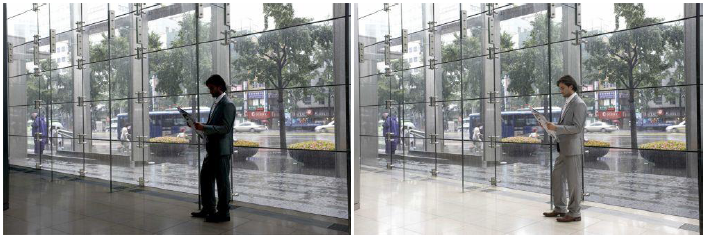CCTV camera manufacturers have long been faced with the dilemma as how to provide the CCTV industry with a camera that could tackle the difficult lighting conditions they so often encountered. After several years of research they came up with the answer, Wide Dynamic Range, or WDR cameras.
The definition of Wide Dynamic Range is the difference between, or ratio of, the largest and smallest possible values of a measurable quantity, such as sound or light. As it pertains to video surveillance cameras, it is the ratio between the lightest and darkest elements in the video area being viewed.
Before the introduction of the WDR camera (first introduced commercially by Fuji in 2003) there were often issues when placing a camera in an area that was either highly backlit or one that exhibited a wide range of lighting conditions throughout the day. Under those conditions, a person would be seen almost in silhouette, making it nearly impossible to see their face. Often referred to as the “bloom effect”, a camera would pick up the brighter light outside and subsequently auto set the iris. Once the lighting eventually normalized, the image would then become usable again.
Implementing WDR cameras in those environments, would solve the silhouette issue, and provide a high-quality image of a person as they entered the store. WDR technology would also allow the ability to view both the inside and outside of a location at the same time. Figure 1, below, illustrates the obvious visual differences for a camera without WDR and with WDR.
Most CCD sensors found today on standard (non-WDR) cameras can acquire a contrast of roughly 1:1000 (60 dB). WDR cameras can operate in a much higher range, usually 1:1800 up to 1:5600 (65-75 dB) achieving the maximum contrast of an image. To do this, WDR cameras have two Charge-Coupled Devices (CCDs), one high speed and the other low speed, both of which are designed to take multiple scans of the same image in order to provide a clear and balanced image. The low speed CCD first scans the image in normal lighting conditions followed by the high speed CCD which scans the image with the stronger light in the background. The image processor in the camera then combines these two images to provide one clear and balanced image.
Though priced slightly higher than non-WDR cameras, WDR cameras have proven themselves to be a valuable addition to any analog or IP-based video surveillance system if strategically deployed. Common uses include store front glass egresses, shipping and receiving dock doors,and parking lot areas.
As always, when choosing among the appropriate camera brands and technology alternatives for your specific application, be sure to consult a qualified security integrator, one who will objectively present options and recommendations to meet your budgetary, technology support and asset protection goals.

